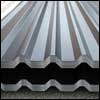The much-awaited boom in industrial and infrastructure development in 2014, particularly after the general elections, is expected to boost the roofing and cladding market in India. Growth in these two critical sectors would not only spur the roofing industry but also encourage roofing manufacturers to launch high-quality, innovative and technically advanced roofing systems.
That roofing is an important component of the construction industry is evident from the fact that it accounts for over 25 per cent of the total building construction cost. There are many roofing options in the Indian roofing sector, such as asbestos cement fibre sheets, corrugated galvanised iron sheets, aluminium corrugated sheets, colour coated metal sheets, reinforced cement concrete, asphaltic roofing, red mud plastic, PVC, and clay tiles. By far, asbestos fibre cement sheets are more in demand because they are considered to be strong and durable, weather-proof and non-corrosive in nature.
Within the building construction and infrastructure sector, the key areas likely to drive growth in the roofing industry are preengineered buildings and factories, residential and commercial buildings, airport projects, upgradation of railway stations, metro and monorail rail, hotels and resorts, IT parks and hubs, retail malls, hypermarkets and multiplexes, integrated townships and special economic zones.
Rural India is also scaling up demand for roofing, especially asbestos roofing, thanks to the gradual increase in rural income on account of government schemes like NREGA under which jobs are provided to low-income individuals. Affordable housing programmes both at the central and state level have also raised the prospects of the roofing industry.











